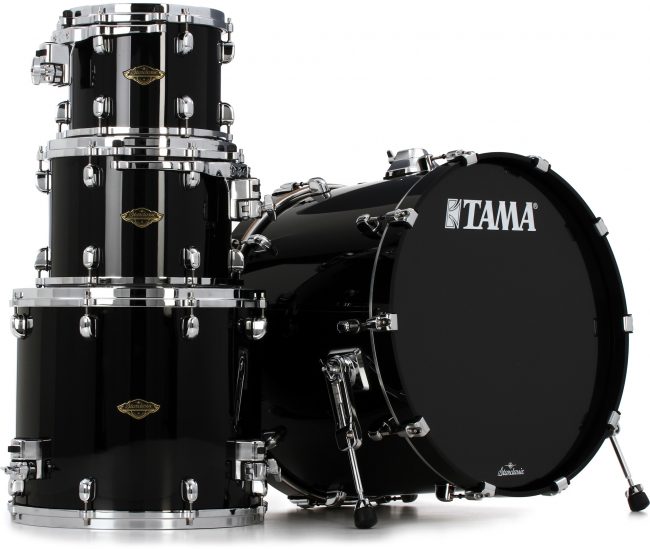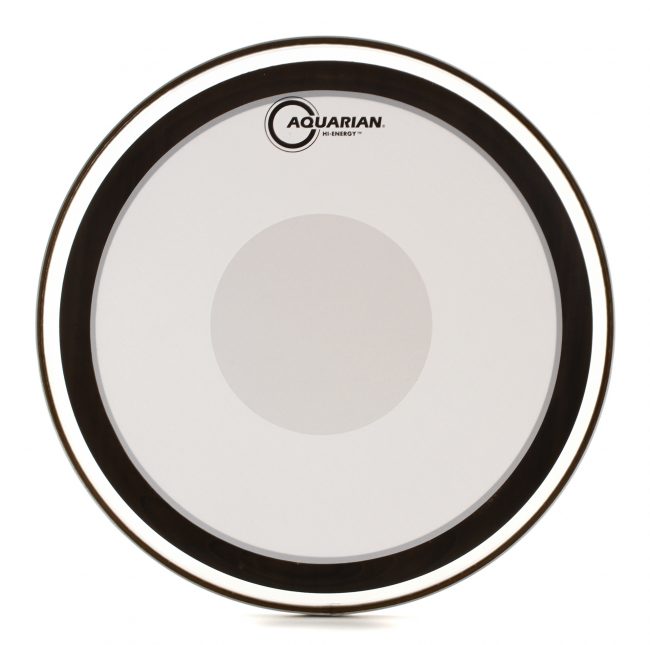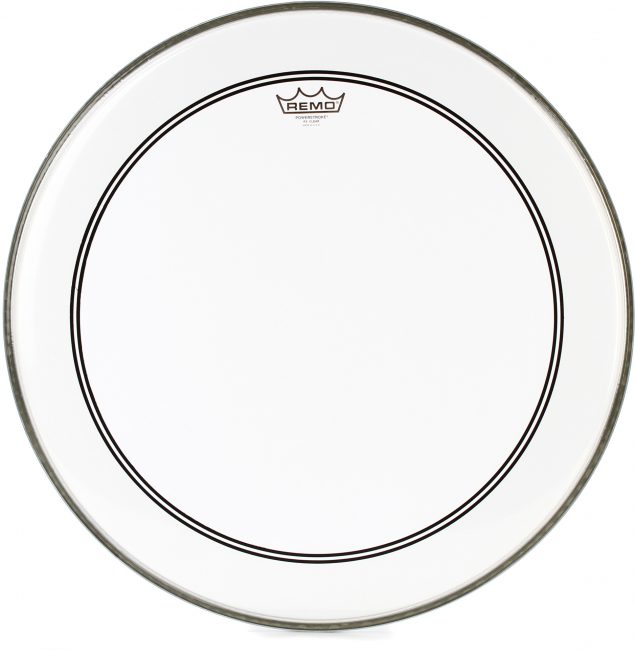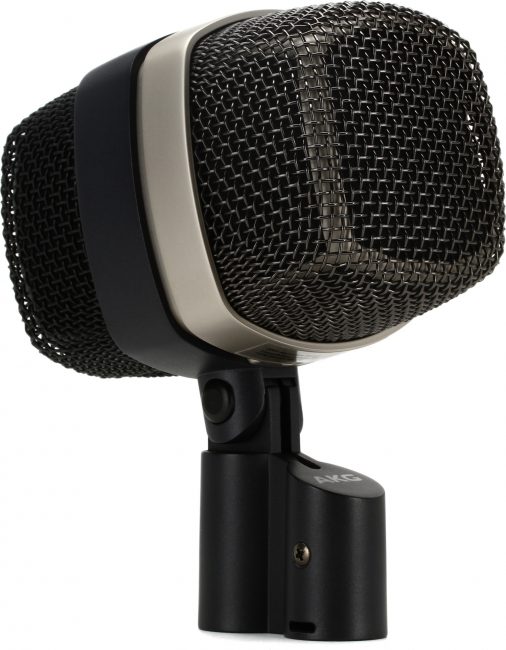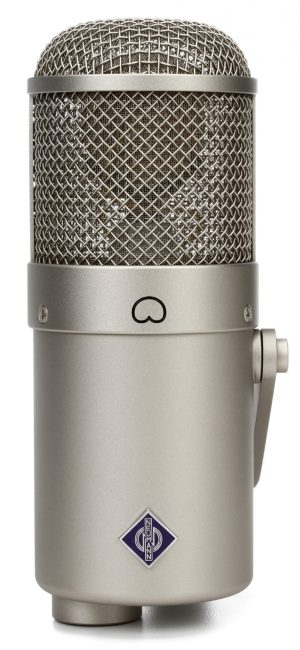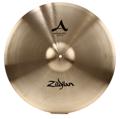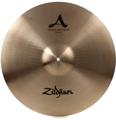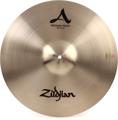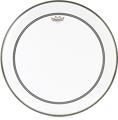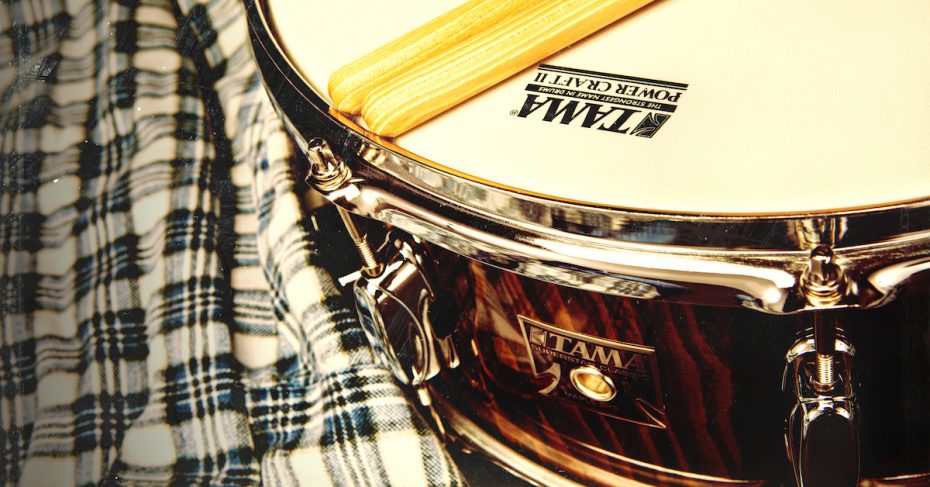
Though he would reject the title, Dave Grohl is a living drum god who has encouraged countless drummers to take up sticks and beat the living heck out of their drums! But what is it about Dave that captured the hearts of so many music lovers? In this article, we’ll take a look at what comprises Dave Grohl’s drum sound, focusing on the two albums that almost instantly established him as one of the great rock ‘n’ roll drummers of all time — Nirvana’s Nevermind and In Utero.
But first, a little history.
As the 1980s came to a close, rock music was having something of an identity crisis. For years, the rock ‘n’ roll landscape was dominated by bands such as Poison, Def Leppard, and Mötley Crüe. Clad in neon bodysuits with teased hair and faces full of makeup, these bands made up an offshoot of hard rock and metal affectionately (or not so affectionately) referred to as “hair metal.” The ethos of hair metal was unapologetically hedonistic, characterized by over-the-top theatrics onstage and larger-than-life sounds in the studio.
But, toward the end of the decade, it seemed that the public was losing its taste for hair metal, and its presence began to slowly fade from the Billboard charts, creating a vacuum to be filled by pop acts like Paula Abdul, Milli Vanilli, and New Kids on the Block. However, outside of the mainstream, a movement was forming, made up of young musicians who eschewed the pomp and artifice of hair metal and sought what they believed to be a more honest form of rock ‘n’ roll — urgent, raw, and imperfect.
Bands like the Pixies, Sonic Youth, Hüsker Dü, and the Melvins had gripped the imaginations of audiences and aspiring musicians looking for an alternative to the stadium-sized glam rock of the 1980s. In Seattle, the influence of those bands had firmly taken root, inspiring a musical and cultural sea change. Flannel replaced spandex. Aqua Net gathered dust on the shelves. Musicians were stripping back their gear and their style to the essentials. It was in that environment that Nirvana was incubated, and they would carry that attitude with them into the mainstream, redefining rock music in the process.
Joining Nirvana
As most Nirvana fans are aware, Dave was not Nirvana’s first drummer. In fact, up until he joined, the band had no less than four drummers. Nirvana’s first record, Bleach, was recorded with Chad Channing behind the kit, who would also play on the band’s Smart Studio recordings. But when Kurt Cobain and Krist Novoselic saw Dave onstage playing with his group, Scream, they knew they had to recruit him. Arguably, it was this decision that helped take Nirvana’s sound to the next level.
Dave is a self-taught drummer with a distinctive style. He’s a notoriously forceful player, attacking every part of the kit. But his style is not defined by power only. Before he switched to the skins, Dave was primarily a guitarist and a songwriter, so when he sat behind the kit, he approached it like a melodic instrument, creating rhythmic hooks and always serving the song first rather than showing off his chops. We’ll examine some of the gear and recording techniques related to Dave’s drum sound on Nevermind and In Utero, but the key component to Dave’s drum sound is… well, Dave!
Setting Up the Kit
During his Nirvana years, Dave favored TAMA drum kits — a TAMA Granstar, a TAMA Granstar II, and a TAMA Artstar II, with either a Superstar or Artwood snare drum. According to Nirvana’s drum technicians, Barrett Jones and Mike Dalke, Dave’s kits all featured the same configuration:
- 8 x 14-inch snare drum
- 14 x 15-inch rack tom
- 16 x 18-inch floor tom
- 16 x 24-inch bass drum
Suffice it to say, Dave likes massive drums! The 14 x 15-inch rack tom is definitely a standout, as is the larger, 24-inch bass drum. However, it’s worth noting that the bass drum has a relatively shallow depth of 16 inches. It may seem counterintuitive, but a shallower kick tends to produce a bigger sound because it takes less effort to push air through the drum, allowing it to open up and deliver a punchy tone with a more focused low-end resonance. John Bonham also preferred a shallow bass drum and, like Dave, is revered for his epic kick-drum sound.
For his cymbals, Dave exclusively used Zildjian As, outfitting his kit with a 22-inch Zildjian A ride, an 18-inch Zildjian A crash, a 20-inch Zildjian A crash, and 15-inch Zildjian A hi-hats, all mounted on TAMA hardware with one exception. Dave liked to keep his hi-hats at head height and relied on a custom Sonor hi-hat stand, which Barrett Jones says is the only one that was tall enough to fit the bill. Dave chose Remo drumheads for everything but his snare drum batter head, which was fitted with an Aquarian Hi-Energy snare drumhead to withstand Dave’s heavy-hitting snare technique that was made all the heavier by Dave’s preference for playing 5B and 2B drumsticks backward.
Recording Nevermind
Nirvana had some minor success with their debut album, Bleach. Produced by Jack Endino and released on Seattle’s seminal indie record label, Sub Pop, Bleach garnered the attention of music critics and sold a respectable amount of copies for an independent band. For their second release, Nirvana teamed up with producer Butch Vig, whom Kurt had approached after being impressed by Butch’s work with Killdozer, a Madison, Wisconsin-based post-hardcore band. Kurt, Krist, and Chad Channing ventured out to Butch’s Smart Studios, which was inconspicuously nestled in Madison’s industrial east side. In five days, they laid down eight songs. While only three songs would see a proper release (“Polly,” “Dive,” and “Here She Comes Now”), the material was strong enough to spark the interest of major labels including the David Geffen Company (DGC), who signed the band in 1990.
Label executives and A&R folks at DGC suggested a number of producers who could helm Nirvana’s sophomore album. But Kurt and Krist insisted on working with Butch, who had yet to meet Dave. When Butch listened to the rehearsal tapes the band sent him prior to recording, he was blown away by Dave’s powerful drumming and instantly recognized the impact it had on the band. The collaboration between Butch and Dave on Nevermind would lead to one of the most celebrated drum sounds in the annals of rock music.
Nevermind was recorded at Sound City in Van Nuys, California. Though visually unassuming, Sound City had a rich history of great recordings from artists such as Fleetwood Mac, Tom Petty, Neil Young, Pat Benatar, and innumerable others. In 2013, Dave Grohl made his directorial debut with a documentary about Sound City, which is required viewing for every music lover. As recounted in the documentary, Sound City, the live room was known for having a great drum sound, which came from serendipity rather than design. Butch and Dave both attest that Sound City’s effect on Nevermind‘s drum sound cannot be understated. Sound City was also home to a custom-built Neve 8078 recording console that played a major role in the sonics of Nevermind. In fact, Dave was so infatuated with the board that he purchased it for his personal studio, Studio 606, which is also detailed in the documentary.
According to Butch, miking Dave’s kit was a straightforward affair, utilizing common studio microphones:
- Kick: AKG D12 and Neumann U 47 FET
- Snare: Shure SM57 and AKG C 451
- Hi-hat: Neumann KM 84
- Toms: Sennheiser MD 421s
- Overheads: AKG C414 stereo pair
- Room: Neuman U 87 stereo pair, 20 feet from Dave’s drum kit
Butch did employ one untraditional miking technique: a kick-drum tunnel. A kick-drum tunnel is exactly what it sounds like — a tunnel that extends out from the kick drum, the purpose of which is to capture more low end while minimizing bleed. The kick-drum tunnel used on Nevermind was constructed from two large drum cases glued together and a blanket draped over the space between it and the kick. Butch placed the AKG D12 inside the tunnel, approximately three to four feet in, and miked the end of the tunnel with the Neumann U 47 FET.
Once Nirvana and Butch wrapped the recording session, the tapes were sent to mix engineer Andy Wallace — a legend in his own right — who had a major influence on the sound of rock in the ’90s. Over the years, there has been some argument over whether or not Andy used samples to fatten up Dave’s drums on Nevermind. Butch, among others, has largely dispelled those rumors… with a caveat. One of Andy’s go-to tricks is to use triggered snare and kick samples to fire off ambience. Sometimes he uses stock samples; sometimes he cuts one-shots from the drummer’s recorded performance. Using samples like this is an excellent way to add space to the snare and kick without feeding kit bleed into the reverb. It gives you an enormous sound that retains the natural characteristics of the drums.
Recording In Utero
By the time Nirvana embarked on their third record, In Utero, they were an international phenomenon, even surpassing Michael Jackson at one point to take the top spot on the Billboard 200. Sometime after the release of Nevermind, Kurt decided that he no longer cared for the record, believing it to be too polished and, in his words, one-dimensional. For In Utero, he wanted to create a record that was raw, jarring, and aggressive. So, he and the group recruited Steve Albini, who produced such records for groups like the Pixies, PJ Harvey, and The Jesus Lizard.
At Steve’s suggestion, the session was booked at Pachyderm Studio in Cannon Falls, Minnesota — a secluded facility 50 miles from Minneapolis that had a house on the property in which the band could stay. The rationale for choosing Pachyderm was to eliminate distractions for the band so that they could focus on the creative process. And Steve was already familiar with the studio, having recently recorded PJ Harvey’s album, Rid of Me.
Like Sound City, Pachyderm Studio boasted a Neve console, which they purchased from Jimi Hendrix’s Electric Lady Studios and, to Steve’s utter excitement, was used to record AC/DC’s Back in Black.
The bulk of In Utero was cut live in Pachyderm’s main room, a large ambient space with a lively, organic sound. According to the band, Steve used up to 30 microphones to capture the band in an effort to craft a record that would sound like you were sitting in the room with them as they played.
Information on what mics Steve used to record Dave’s kit is scarce. Though, we know that he used a pair of 1960s Lomo 19A9 Soviet tube condensers for the drum overheads and also on Kurt’s vocals. Steve has an immense microphone collection, and his tastes often veer toward rare and esoteric mics. Unlike some producers, Steve doesn’t adhere to a prescribed recording method. He has some default tricks that he knows work, but he tends to build the recording around the band. However, his approach to recording drums is always to treat the kit as if it were a single instrument and not one made of separate pieces; so, he relies more on ambient mics and room mics to establish the sound of the kit.
One interesting trick Steve used on In Utero was to record Dave in Pachyderm’s artist lounge, a small, dead acoustic space. You can hear the results clearly on “Very Ape,” which has a tight, focused, and slightly lo-fi drum sound that accentuates the track’s driving rhythm and noise-rock aesthetic.
In Utero was recorded and mixed fast (in under two weeks!), and there was controversy surrounding it — with dissatisfaction coming from the label and, by some reports, the band. Though the original agreement was that Steve would mix the album, Kurt, Krist, and Dave chose to bring R.E.M. producer Scott Litt aboard to tweak and finalize the record. Litt’s mixes didn’t drastically change the sound of Dave’s kit; he mainly focused on making the vocals clearer and adding more definition to the bass. And while Steve and Butch took vastly different approaches to recording Dave’s performances, his signature style and infectious, energetic playing are unmistakable on both albums.
Conclusion
As we said, the best way to sound like Dave Grohl is to be Dave Grohl. But, as drummers, we can take inspiration from his style, his gear choices, and the recording techniques used to craft his studio sound in order to forge our own drumming identity. Part of Dave’s lasting success in the music industry is undoubtedly his infectious positivity and matchless work ethic. And, perhaps, that’s the most important takeaway!


